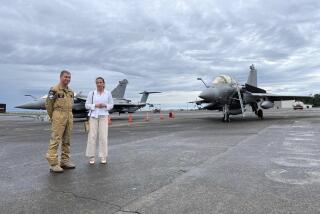100 more U.S. Marines and sailors, carrier Washington sent to help Philippines

- Share via
WASHINGTON — One hundred additional U.S. Marines and sailors flew to the Philippines on Monday as part of a growing international effort to help survivors of one of the largest Pacific storms on record.
Rescuers are still in the early stages of reaching remote areas devastated by Typhoon Haiyan, which officials say may have killed thousands of people as it lashed the island chain with winds of more than 200 mph and widespread flooding.
Two U.S. military cargo planes carrying water and generators, along with a squad of Marines, left Manila for the hard-hit city of Tacloban on the island of Leyte.
In a sign that the U.S. is significantly ramping up its response, the aircraft carrier George Washington will be moved to the Philippines to assist with the growing effort to aid victims, two senior Navy officials said. They requested anonymity because the deployment had not yet been publicly announced.
The carrier “is preparing to deploy from Hong Kong, where they are on a port visit, to the Philippines to assist with relief efforts,” one of the officials said.
The official said the specific tasks the carrier would perform was still being worked out.
But a carrier positioned offshore will potentially give U.S. forces the ability to ferry supplies to isolated towns, though only in small amounts because of the size and number of aircraft that can land on its deck. It will also allow the U.S. to move badly the injured aboard for immediate medical care.
George Washington “has medical facilities, lift capability, water and food supply,” the Navy official said, noting that the carrier Carl Vinson assisted in humanitarian operations in Haiti in 2010 following a deadly earthquake there.
In that operation, the carrier was given additional helicopters to ferry supplies ashore, a move the Navy is likely to repeat in the Philippines.
The carrier should reach the Philippines within a few days.
[Updated at 3 p.m. Nov. 11: Pentagon Press Secretary George Little later officially announced the deployment and said the carrier, which includes a crew of 5,000 sailors and more than 80 aircraft, will be accompanied by the cruisers Antietam and Cowpens and the destroyer Mustin. Other U.S. Navy vessels were already underway for the Philippines, Little said in the statement.]
U.S. military and civilian officials are still helping Philippine authorities assess the scale of the humanitarian disaster from the storm, known in the Philippines as Yolanda.
“There have been a couple of initial flights, but for the most part it’s still the assessment phase,” said Sgt. Ben Eberle, a Marine spokesman. “In the next 24 hours, there should be a significant increase in resupply for Tacloban.”
The additional deployment of Marines and sailors from the U.S. base in Okinawa, Japan, brings the number of U.S. personnel who have responded to the disaster to 180, Eberle said.
A U.S. Agency for International Development assessment team in Leyte province found that in some areas, 90% of the housing had been damaged or destroyed, the U.S. Embassy in Manila said in a statement.
The agency is sending 1,000 rolls of plastic sheeting and 10,000 kits containing soap, toothbrushes and other sanitary supplies from a warehouse in Dubai. It also is sending 55 tons of food, enough to feed 20,000 children and 15,000 adults for four to five days, the embassy said.
Another 1,020 tons of rice is being shipped from stockpiles in Sri Lanka. The rice can feed 60,000 people for a month, the embassy said.
The Marines have sent four MV-22 Osprey airplanes, which can land and take off vertically, as well as five KC-130 refueling planes, which can also be used to transport cargo. Aerial refueling capacity is critical because of the long distances the Osprey must fly to deliver supplies and assess the damage to airfields.
U.S. Navy P-3 Orion aircraft are flying over hard-hit areas to help with search and rescue efforts, the Navy said.
ALSO:
U.S., EU resume negotiations on free trade agreement
Preah Vihear temple grounds belong to Cambodia, U.N. court rules
Egyptian court extends detention of ousted president Mohamed Morsi
Twitter: @DavidCloudLAT
More to Read
Sign up for Essential California
The most important California stories and recommendations in your inbox every morning.
You may occasionally receive promotional content from the Los Angeles Times.











